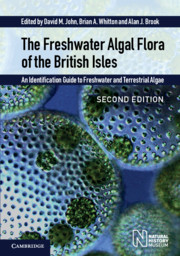 The Freshwater Algal Flora of the British Isles
The Freshwater Algal Flora of the British Isles Published online by Cambridge University Press: 12 January 2024
This phylum was established to accommodate those algae with intracellular blue-green coloured cyanelles rather than chloroplasts, but where the main part of the cell cannot be assigned easily to another phylum such as the diatoms. Cyanelles are evolutionary steps between blue-green algae and chloroplasts, though are more like the latter than the former; they cannot exist independently of the host cell. The cyanelles of some genera have been treated as separate species, with their own Latin name, but as they cannot exist independently of the host cell, this is a doubtful practice. There is no reason to believe that the various types of host cell are closely related to each other. The phylum is therefore probably artificial. Ideally, organisms with cyanelles should be placed in the phylum which the host cell most closely resembles. However, the phylogenetic relationships of the genera Cyanophora, Glaucocystis and Gloeochaete are still unclear, so the phylum is retained for the time being. However, ribosomal RNA sequences indicate that the cyanelles of these three organisms do show considerable similarity (Helmchen et al., 1995). These authors also showed that the cyanelles of another cyanelle-containing organism, Glaucosphaera vacuolata (not recorded from British Isles), indicate that this belongs to the Rhodophyta.
Gloeochaete was included in the green algal order Tetrasporales in the 2002 Flora and 2003 Coded List and its coded number is retained here in the hope that the taxonomic relationships of these organisms will soon be resolved, so it seems unnecessary to make the change now. It is listed in the Glaucophyta here, as was suggested originally by Kies (1976).
1 Cells motile with 2 unequal flagella emerging from a subapical depression…………….Cyanophora
1 Cells non-motile……………………………………………. 2
2 Cells ellipsoid; cyanelles twisted around each other and typically 8 towards each end; reproduce by autospores ………………………………..Glaucocystis
2 Cells spherical; cyanelles usually ovoid or sausageshaped and lying in a cup-shaped region; reproduce by biflagellate zoospores ………………..Gloeochaete
Cyanophora Korshikov 1924
05050000
Cells flattened, ellipsoid, possessing 2 unequal flagella emerging from a subapical depression. One to 2 (when mature) cyanelles per cell. Reproduction by longitudinal division into 2 daughter cells each with a cyanelle.
Three known species.
Cyanophora paradoxa Korshikov 1924
05050010 Pl. 71H (p. 278)
Cells 2–3 μm thick, 5–8 μm wide, 8–12 μm long; 1–2 blue cyanelles.
Plankton of shallow lakes with hard, nutrient-rich water.
To save this book to your Kindle, first ensure [email protected] is added to your Approved Personal Document E-mail List under your Personal Document Settings on the Manage Your Content and Devices page of your Amazon account. Then enter the ‘name’ part of your Kindle email address below. Find out more about saving to your Kindle.
Note you can select to save to either the @free.kindle.com or @kindle.com variations. ‘@free.kindle.com’ emails are free but can only be saved to your device when it is connected to wi-fi. ‘@kindle.com’ emails can be delivered even when you are not connected to wi-fi, but note that service fees apply.
Find out more about the Kindle Personal Document Service.
To save content items to your account, please confirm that you agree to abide by our usage policies. If this is the first time you use this feature, you will be asked to authorise Cambridge Core to connect with your account. Find out more about saving content to Dropbox.
To save content items to your account, please confirm that you agree to abide by our usage policies. If this is the first time you use this feature, you will be asked to authorise Cambridge Core to connect with your account. Find out more about saving content to Google Drive.